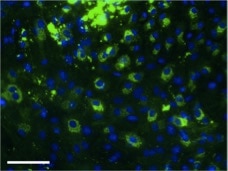Mouse Osteopontin/OPN Biotinylated Antibody Summary
Leu17-Asn294 (Glu99Gly)
Accession # Q547B5
Applications
Mouse Osteopontin/OPN Sandwich Immunoassay
Please Note: Optimal dilutions should be determined by each laboratory for each application. General Protocols are available in the Technical Information section on our website.
Preparation and Storage
- 12 months from date of receipt, -20 to -70 °C as supplied.
- 1 month, 2 to 8 °C under sterile conditions after reconstitution.
- 6 months, -20 to -70 °C under sterile conditions after reconstitution.
Background: Osteopontin/OPN
Osteopontin (OPN, previously also referred to as transformation-associated secreted phosphoprotein, bone sialoprotein I, 2ar, 2B7, early T lymphocyte activation 1 protein, minopotin, calcium oxalate crystal growth inhibitor protein), is a secreted, highly acidic, calcium-binding, RGD-containing, phosphorylated glycoprotein originally isolated from bone matrix. Subsequently, OPN has been found in kidney, placenta, blood vessels and various tumor tissues. Many cell types (including macrophages, osteoclasts, activated T-cells, fibroblasts, epithelial cells, vascular smooth muscle cells, and natural killer cells) can express OPN in response to activation by cytokines, growth factors or inflammatory mediators. Elevated expression of OPN has also been associated with numerous pathobiological conditions such as atherosclerotic plaques, renal tubulointerstitial fibrosis, granuloma formations in tuberculosis and silicosis, neointimal formation associated with balloon catheterization, metastasizing tumors, and cerebral ischemia. Mouse OPN cDNA encodes a 294 amino acid (aa) residue precursor protein with a 16 aa residue predicted signal peptide that is cleaved to yield a 278 aa residue mature protein with an integrin binding sequence (RGD), and N- and O-glycosylation sites. OPN has been shown to bind to different cell types through RGD-mediated interaction with the integrins alpha v beta 1, alpha v beta 3, alpha v beta 5, and non-RGD-mediated interaction with CD44 and the integrins alpha 8 beta 1 or alpha 9 beta 1. Functionally, OPN is chemotactic for macrophages, smooth muscle cells, endothelial cells and glial cells. OPN has also been shown to inhibit nitric oxide production and cytotoxicity by activated macrophages. Human, mouse, rat, pig and bovine OPN share from approximately 40% - 80% amino acid sequence identity. Osteopontin is a substrate for proteolytic cleavage by thrombin, enterokinase, MMP-3 and MMP-7. The functions of OPN in a variety of cell types were shown to be modified as a result of proteolytic cleavage (2, 3).
- Ann. N.Y. Acad. Sci., vol. 760, 1995, Apr. 21.
- Senger, D.R. et al. (1996) Biochim. Biophys. Acta. 1314:13.
- Agnihotri, R. et al. (2001) J. Biol. Chem. 276:28261.
Product Datasheets
Citations for Mouse Osteopontin/OPN Biotinylated Antibody
R&D Systems personnel manually curate a database that contains references using R&D Systems products. The data collected includes not only links to publications in PubMed, but also provides information about sample types, species, and experimental conditions.
5
Citations: Showing 1 - 5
Filter your results:
Filter by:
-
Secreted osteopontin from CD4+ T�cells limits acute graft-versus-host disease
Authors: N Aggarwal, ME Deerhake, D DiPalma, SK Shahi, MR Gaggioli, AK Mangalam, ML Shinohara
Cell Reports, 2021-12-28;37(13):110170.
Species: Mouse, Transgenic Mouse
Sample Types: Cell Culture Supernates
Applications: ELISA Detection -
Osteopontin attenuates aging-associated phenotypes of hematopoietic stem cells
Authors: N Guidi, M Sacma, L Ständker, K Soller, G Marka, K Eiwen, JM Weiss, F Kirchhoff, T Weil, JA Cancelas, MC Florian, H Geiger
EMBO J, 2017-03-02;0(0):.
Species: Mouse
Sample Types: Cell Culture Supernates
Applications: ELISA Development (Detection) -
Mesenchymal stem cells from cortical bone demonstrate increased clonal incidence, potency, and developmental capacity compared to their bone marrow-derived counterparts
J Tissue Eng, 2016-08-16;7(0):2041731416661.
Species: Rat
Sample Types: Whole Tissue
Applications: IHC-P -
Cutting edge: Role of osteopontin and integrin alphav in T cell-mediated anti-inflammatory responses in endotoxemia.
Authors: Inoue M, Shinohara M
J Immunol, 2015-05-13;194(12):5595-8.
Species: Mouse
Sample Types: Cell Culture Supernates
Applications: ELISA Development (Detection) -
Lack of requirement of osteopontin for inflammation, bone erosion, and cartilage damage in the K/BxN model of autoantibody-mediated arthritis.
Authors: Jacobs JP, Pettit AR, Shinohara ML, Jansson M, Cantor H, Gravallese EM, Mathis D, Benoist C
Arthritis Rheum., 2004-08-01;50(8):2685-94.
Species: Mouse
Sample Types: Serum
Applications: ELISA Development
FAQs
No product specific FAQs exist for this product, however you may
View all Antibody FAQsReviews for Mouse Osteopontin/OPN Biotinylated Antibody
Average Rating: 5 (Based on 1 Review)
Have you used Mouse Osteopontin/OPN Biotinylated Antibody?
Submit a review and receive an Amazon gift card.
$25/€18/£15/$25CAN/¥75 Yuan/¥2500 Yen for a review with an image
$10/€7/£6/$10 CAD/¥70 Yuan/¥1110 Yen for a review without an image
Filter by:


